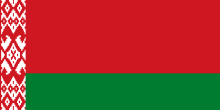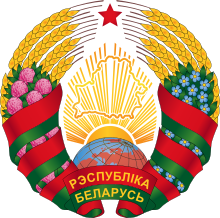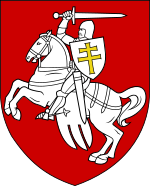National symbols of Belarus
Upon the independence of Belarus from the Soviet Union, the country resurrected national symbols that were used before the Soviet era. These included a flag of red and white stripes and a coat of arms consisting of a charging knight on horseback. These national symbols were replaced by Soviet-era symbols in a disputed 1995 vote. Those two symbols, along with the national anthem, are the constitutionally defined national symbols of Belarus.
Law
In the 1994 Constitution of Belarus, Article 19 lists the official symbols of the country. Article 19 reads:
The symbols of the Republic of Belarus as a sovereign state shall be its national flag, national emblem and national anthem.[1]
Each national symbol is further defined by its respective laws. Uses of the national symbols are covered in the relevant law of each symbol.
National flag

The national flag has been in use since June 7, 1995, one of two symbols adopted in the contested 1995 referendum. The main element of the flag is a red and green bicolour, then decorated with an ornament pattern at the hoist position. The current flag is a modification of the
Despite being replaced, the former flag of Belarus is used by those who oppose the current Belarusian President Alexander Lukashenko.[2] The former flag consisted of a white background with a red horizontal stripe in the middle. It was used by the Belarusian Democratic Republic and immediately after independence from the Soviet Union in 1991.
National emblem

The other national symbol that was adopted following a contested 1995 referendum was the national emblem. The elements of the emblem include a ribbon in the colours of the national flag, a map of Belarus, wheatears and a
The national emblem that was used at the time of the BNR and post-Soviet independence was called the
National anthem
The only symbol that hasn't changed over during independence is the national anthem. Adopted during the Soviet era, "
Historical symbols
White-red-white flag

Since the early 20th century, the Belarusian national liberation movement has been using a
Pahonia

Unofficial symbols
Other than the national flag, anthem and emblem, Belarus has several unofficial symbols. The
-
a male wisent in a Minsk zoo
-
a white stork
-
cornflower
-
Cross of St. Euphrosyne
See also
- List of flags of Belarus
- List of Belarusian coats of arms
- Belarusian heraldry
References
- ^ Webportal of the President of the Republic of Belarus Section One of the Constitution Archived 2008-02-16 at the Wayback Machine. Published 1994, amended in 1996. Retrieved June 7, 2007.
- ^ (in Belarusian) Webpage showing photos of the white-red-white flag being used by the group Zubr
- ^ Гербы БССР. Геральдикум (in Russian). Русский Центр флаговедения и геральдики. 2003-12-16. Retrieved 2010-04-28.
- ^ "The Coat of Arms of Lithuania". Office of the Seimas. 2006-01-10. Retrieved 2010-04-28.
- ^ "Аб Дзяржаўным гімне Рэспублікі Беларусь" (in Belarusian). President of the Republic of Belarus. 2002-07-02. Archived from the original on 2010-07-25. Retrieved 2007-10-13.
- ^ a b "State System - State Symbols". President of the Republic of Belarus. Retrieved 2007-10-13.
- ISBN 978-0-7425-5558-7. Retrieved 26 August 2012. (Backcover)
- ^ Khorevsky, Sergey. Клаўдзi Дуж-Душэўскi. Сьцяг [Claudius Duzh-Duszewski. Flag]. Наша Ніва (in Belarusian). Archived from the original on 26 February 2012. Retrieved 26 August 2012.
- ISBN 978-0-300-13435-3.
- ^ Kotljarchuk, Andrej (14 September 2020). "The Flag Revolution. Understanding the political symbols of Belarus". balticworlds.com. Centre for Baltic and East European Studies (CBEES), Södertörn University. Archived from the original on 25 December 2020. Retrieved 7 December 2020.
- ^ Lyalkov, Igor. Пытаньне дзяржаўнай сымболікі ў Беларусі: гісторыя і сучасны стан [The issue of state symbols in Belarus: history and current state]. Pahonia-plakat.narod.ru (in Belarusian). Malyavanych. Archived from the original on 10 November 2013. Retrieved 26 August 2012.
- ^ "В Минск привезут копию креста Евфросинии Полоцкой".
- ^ "Information about heraldic symbols". Brest Regional Executive Commettee [sic]. Archived from the original on 2007-06-25. Retrieved 2007-10-13.
- ^ "Аист – символ Беларуси | Официальный сайт Республики Беларусь".



